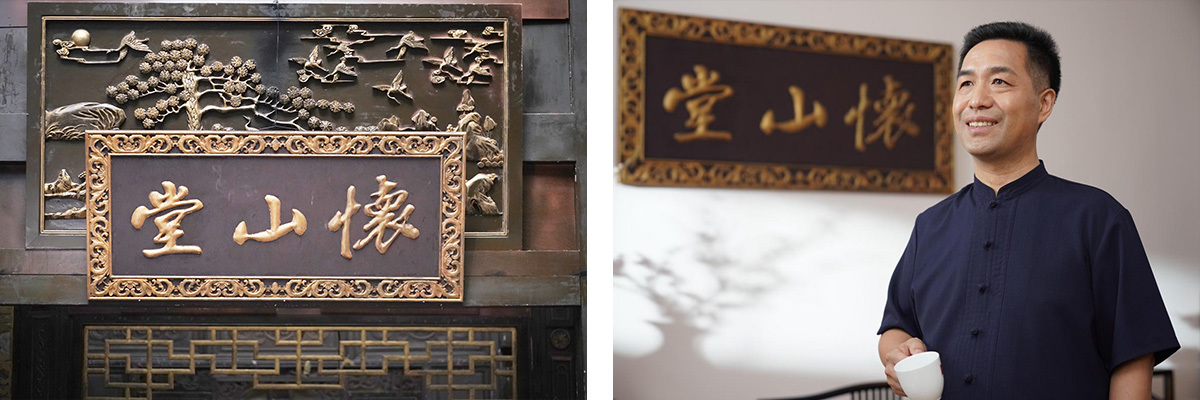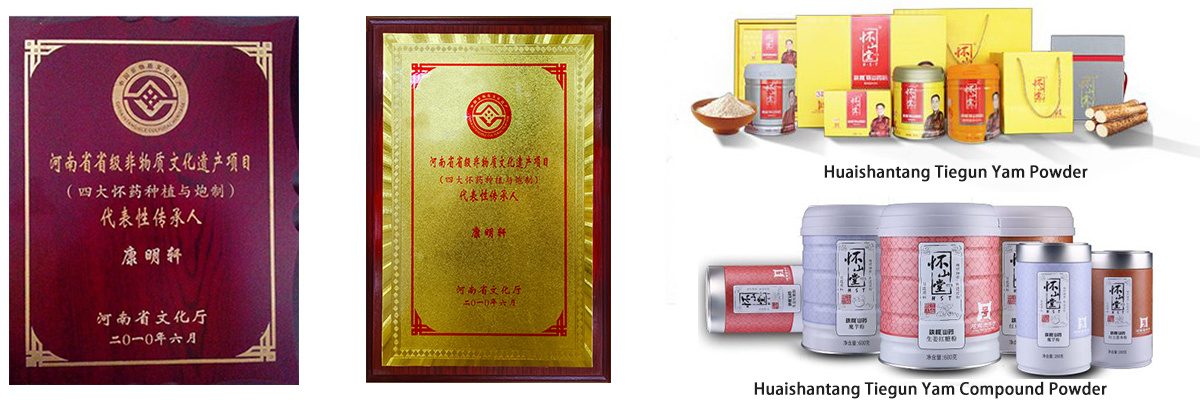1. Communication of the Kang family 's century-old "Leaving Adequate Leeway" culture
In the 38th year of the reign of Emperor Qianlong of the Qing Dynasty (1773 AD), Kang Yusheng (see page 508 of the Kang family tree book), a native of former Suri (now Kangdian Town, Gongyi City, Zhengzhou) in Henan Province and the tenth descendant of the Heluo Kang’s family, admiring the reputation of Huai medicine, crossed the Yellow River and removed to the Leng Village in the southwest of Huaiqing Prefecture (now the Leng Village in the southwest of Wenxian County, Henan Province), began to engage in the planting, processing and trade of Huai medicines, and established the firm name "Huaishantang".

After more than 248 years and eight generations of inheritance, the eighth generation of Huaishantang is Kang Mingxuan, also the eighteenth generation of the Kang family.
Huaishantang brand inheritance pedigree
| Generation | Name | Sex | Date of birth and death | Mode of inheritance | Art time | Current residence |
| G 1 | Kang Yusheng | male | Birth and death unknown | Birth and death unknown | Birth and death unknown | |
| G 2 | Kang Lin | male | 1783-1848 | Handed down from the older generations of the family | Birth and death unknown | |
| G 3 | Kang Mingde | male | 1815-1874 | Handed down from the older generations of the family | Birth and death unknown | |
| G 4 | Kang Shueru | male | 1840-1912 | Handed down from the older generations of the family | Birth and death unknown | |
| G 5 | Kang Tongle | male | 1881-1927 | Handed down from the older generations of the family | Birth and death unknown | |
| G 6 | Kang Yinglu | male | 1916-1984 | Handed down from the older generations of the family | Birth and death unknown | |
| G 7 | Kang Fuan | male | 1946 | Handed down from the older generations of the family | 1958 | Wen County |
| G 8 | Kang Mingxuan | male | 1969 | Handed down from the older generations of the family | 1981 | Wen County |
2. Inheritance of the skills of planting and processing of the four major Huaiqing medicines as "intangible cultural heritage"
Kang Mingxuan made outstanding contributions to the inheritance and development of the planting and processing of four major Huaiqing medicines. As early as in 2000, he began to do a comprehensive and in-depth research on the planting, processing, identification, use for health care of Haiqing medicines, as well as the types, quantity, current situation and inheriting of the intangible cultural heritage about such medicines, and established archives for them. He successively wrote papers and works such as Huai Chrysanthemum Planting Technology and Application, Tiegun Huai Yam Planting Technology and Application, and The Necessity of Cultural Marketing of Huai Medicine Enterprises. He also established a teaching base, which was awarded the "intangible cultural heritage research demonstration base and production protection demonstration base".
Kang Mingxuan widely collected the related items of the four major Huaiqing medicines as the basic display content of the intangible cultural heritage Museum of the four major Huaiqing medicines, which improved the protection of the four major Huaiqing medicines, so that the endangered and important four major Huaiqing medicines and a group of inheritors have been effectively protected. Moreover, the awareness of cultural heritage protection in the whole society has been continuously improved.

Based on his in-depth researches on the planting and processing of Huaiqing medicines, Kang Mingxuan participated in the drafting and compilation of the text of the National Standard for Four Major Huaiqing Medicines of Geographical indication Products. Kang Mingxuan created the planting model of "company + base + farmer", which was fully affirmed by Hu Jintao, then General Secretary of CPC Central Committee, when he inspected Huaishantang standardized planting base on September 8, 2008,
After years of research and improvement, Kang Mingxuan's Huai medicine planting and processing technology features science, standardization, transforming the past into the present, and bringing forth the new. The Huai medicine planting technology developed and improved by Kang Mingxuan is suitable for large-scale mechanical operations, which improves the planting efficiency, reduces the physical consumption during excavation, and avoids the physical damage to farmers during harvest caused by traditional planting methods. Such planting technology is greatly welcomed by pharmaceutical farmers and has been popularized. The processing technology of Huai medicine introduced by him after improvement not only keeps the meaning and efficacy of ancient methods, but also conforms to the requirements of modern society for environmental protection and health care. On the basis of inheriting the ancient method, Kangmingxuan pays attention to the scientific research and innovation of yam processing technology, and have obtained national invention patents for a number of his innovative processes and methods.
In terms of planting, Kang Mingxuan, by working with Wenxian Agricultural Science Institute in 2009, improved the original "chicken bone-lke yam" and carefully cultivated the "Tiegun" brand yam, which was registered as a trademark for protection.
List of national invention patents of yam processing technology obtained by Kang Mingxuan
| Date of announcement | Handle projects | Patent No |
| 2010.1.20 | A method for sulfur-free processing of yam | ZL200610128279.7 |
| 2015.6.10 | A reparation method for preparation method for yam and yellow rice wine | ZL201210342524.X |
| 2015.6.10 | A reparation method for nutritional powder of Huai yam | ZL201210342535.8 |
| 2016.5.11 | A method for preparing Huai Rehmannia compound drink | ZL201210342522.0 |
| 2016.11.30 | A preparation method for Huai Yam beverage | ZL201210342532.4 |
In terms of processing technology, Kang Mingxuan eliminated the shortcomings of the traditional sulfur fumigation method. The sulfur-free processed yam can retain more than 93% of its nutrients, while the ancient method of stir-frying yam with bran makes the product more effective and more mellow The Tiegun yam powder and compound powder thus developed have preserved the nutrients of fresh yam to the greatest extent, making it more convenient to eat yam and easier to be absorbed by human body.

3. Inheritance of top ten skills of the Kang family
When Huaishantang passed down to Kang Shuoru (1840-1912) the fourth generation of the Kang family, the planting and processing of Huai medicines had reached a considerable scale. The processing technology was perfect, and the use of Huai medicine for diagnosis and treatment was also becoming mature. The Kang family combined the ancient prescription for diagnosis and treatment of Huai medicines popular among the local people with that learned from the local old Chinese medicine physicians with an open mind, so that he gradually found a set of traditional Chinese medicine treatment prescriptions based on Huai yam medicine and combined with other traditional Chinese medicines.
At present, Kang's traditional Chinese medicine diagnosis and treatment methods are mainly based on Huai yam and makes full use of the relationship between the compatibility of traditional Chinese medicines for diagnosis and treatment. These diagnosis and treatment methods mainly feature the differentiation of symptoms and modification according to symptoms, the regulation of the relationship between the viscera. The diagnosis and treatment items include infertility, depression, obesity, hypertension, hypoglycemia, gout, growth promotion, lupus erythematosus, clearing heart and nourishing lung, and skin diseases. At present, we have summarized Kang's prescriptions and applied for Henan provincial intangible cultural heritage technology inheritance project step by step. We will rearrange these ancient and unilateral prescriptions, make reasonable matching in combination with the physical needs of modern people, and use modern processing techniques to make dietary regimen products easier for modern people to take.








